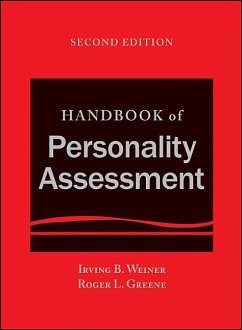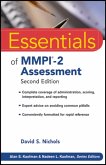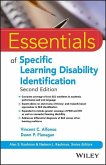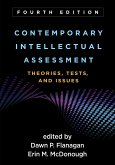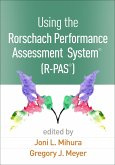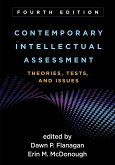Irving B. Weiner (University of Denver), Roger L. Greene (Pacific Graduate School of Psychology, Palo Alto,
Handbook of Personality Assessment
Irving B. Weiner (University of Denver), Roger L. Greene (Pacific Graduate School of Psychology, Palo Alto,
Handbook of Personality Assessment
- Gebundenes Buch
- Merkliste
- Auf die Merkliste
- Bewerten Bewerten
- Teilen
- Produkt teilen
- Produkterinnerung
- Produkterinnerung
The essential resource for personality assessment, updated and expanded The Handbook of Personality Assessment provides comprehensive guidance on the administration, scoring, and interpretation of the most widely-used instruments.
Andere Kunden interessierten sich auch für
![Essentials of Mmpi-2 Assessment Essentials of Mmpi-2 Assessment]() David S. Nichols (Pacific University, Forest Grove, OR)Essentials of Mmpi-2 Assessment60,99 €
David S. Nichols (Pacific University, Forest Grove, OR)Essentials of Mmpi-2 Assessment60,99 €![Essentials of Specific Learning Disability Identification Essentials of Specific Learning Disability Identification]() Vincent C. Alfonso (Fordham University, New York, New York)Essentials of Specific Learning Disability Identification60,99 €
Vincent C. Alfonso (Fordham University, New York, New York)Essentials of Specific Learning Disability Identification60,99 €![Psychoanalytic Perspectives on the Rorschach Psychoanalytic Perspectives on the Rorschach]() Paul M. LernerPsychoanalytic Perspectives on the Rorschach72,99 €
Paul M. LernerPsychoanalytic Perspectives on the Rorschach72,99 €![Contemporary Intellectual Assessment Contemporary Intellectual Assessment]() Contemporary Intellectual Assessment131,99 €
Contemporary Intellectual Assessment131,99 €![Using the Rorschach Performance Assessment System(r) (R-Pas(r)) Using the Rorschach Performance Assessment System(r) (R-Pas(r))]() Using the Rorschach Performance Assessment System(r) (R-Pas(r))73,99 €
Using the Rorschach Performance Assessment System(r) (R-Pas(r))73,99 €![Gifts Differing Gifts Differing]() Isabel Briggs MyersGifts Differing25,99 €
Isabel Briggs MyersGifts Differing25,99 €![Contemporary Intellectual Assessment Contemporary Intellectual Assessment]() Contemporary Intellectual Assessment88,99 €
Contemporary Intellectual Assessment88,99 €-
-
-
The essential resource for personality assessment, updated and expanded The Handbook of Personality Assessment provides comprehensive guidance on the administration, scoring, and interpretation of the most widely-used instruments.
Hinweis: Dieser Artikel kann nur an eine deutsche Lieferadresse ausgeliefert werden.
Hinweis: Dieser Artikel kann nur an eine deutsche Lieferadresse ausgeliefert werden.
Produktdetails
- Produktdetails
- Verlag: John Wiley & Sons Inc
- 2 ed
- Seitenzahl: 768
- Erscheinungstermin: 3. April 2017
- Englisch
- Abmessung: 279mm x 221mm x 41mm
- Gewicht: 1920g
- ISBN-13: 9781119258889
- ISBN-10: 111925888X
- Artikelnr.: 46969291
- Herstellerkennzeichnung
- Libri GmbH
- Europaallee 1
- 36244 Bad Hersfeld
- gpsr@libri.de
- Verlag: John Wiley & Sons Inc
- 2 ed
- Seitenzahl: 768
- Erscheinungstermin: 3. April 2017
- Englisch
- Abmessung: 279mm x 221mm x 41mm
- Gewicht: 1920g
- ISBN-13: 9781119258889
- ISBN-10: 111925888X
- Artikelnr.: 46969291
- Herstellerkennzeichnung
- Libri GmbH
- Europaallee 1
- 36244 Bad Hersfeld
- gpsr@libri.de
Irving B. Weiner, PhD, is Clinical Professor of Psychiatry and behavioral Medicine at the University of South Florida and former Director of Psychological Services at the University of South Florida Psychiatry Center in Tampa, Florida. He is a Fellow of the American Psychological Association and of the Association for Psychological Science, a Diplomat of the American board of Professional Psychology in both Clinical and Forensic Psychology, and a licensed psychologist in the state of Florida and is in the practice of clinical and forensic psychology. He is the author of numerous articles and books, and Editor-in-Chief of the 12-volume Handbook of Psychology. Roger L. Greene, PhD, is a professor at the Pacific Graduate School of Psychology in Palo Alto, California, where he served as Director of Clinical Training for twelve years. Dr. Greene has worked in a variety of clinical settings and with different types of patients in his clinical career. His particular area of interest is the assessment and treatment of alcohol and drug abuse. He has written a number of texts and articles on the use of the MMPI-2.
Preface xiii
About the Authors xv
Part 1: Basic Considerations
Chapter 1 History of Personality Assessment 3
Early Events 3
Emergence of Personality Psychology 5
World War II and the Expansion of Clinical Psychology 5
Trends Over Time: Shrinkage and Growth 6
Concluding Comments 9
References 12
Chapter 2 The Personality Assessment Process 15
Purposes of Personality Assessment 15
Preparing for Personality Assessments 16
Conducting Personality Assessments 21
Interpreting Personality Assessment Data 23
Reporting Personality Assessment Findings 29
References 33
Chapter 3 Psychometric Foundations of Assessment 37
Reliability 37
Validity 41
Clinical Decision Making 43
Impediments to Accurate Decisions 53
Concluding Comments 55
References 56
Chapter 4 Ethical Considerations in Personality Assessment 59
Student Disclosure of Personal Information (7.04) 60
Bases for Assessments (9.01) 60
Use of Assessments (9.02) 60
Informed Consent in Assessments (9.03) 62
Release of Test Data (9.04) 63
Interpreting Assessment Results (9.06) 63
Assessment by Unqualified Persons (9.07) 64
Obsolete Tests and Outdated Test Results (9.08) 66
Test Scoring and Interpretation Services (9.09) 66
Explaining Assessment Results (9.10) 67
Maintaining Test Security (9.11) 68
Training Students in Personality Assessment 68
Diversity Issues 69
Concluding Comments 72
References 72
Part 2: Self-Report Inventories
Chapter 5 Overview 77
Nature of Self-Report Inventories 77
Item Characteristics 79
Administration and Scoring 85
Method of Scale Development 90
Validity Assessment 92
The Process of Interpretation 101
Future Directions for Assessment with Self-Report Inventories 102
Summary 103
References 103
Chapter 6 Minnesota Multiphasic Personality Inventory-2 105
History 105
Administration 109
Scoring 110
Validity 111
Interpretation 116
Applications 153
Psychometric Foundations 154
Concluding Comments 156
References 156
Chapter 7 Minnesota Multiphasic Personality Inventory-Adolescent 161
History 161
Administration 165
Scoring 165
Validity 166
Interpretation 170
Applications 190
Psychometric Foundations 192
Concluding Comments 193
References 193
Chapter 8 Minnesota Multiphasic Personality Inventory-2-Restructured Form
197
History 197
Administration 200
Scoring 200
Validity 201
Interpretation 207
Applications 220
Psychometric Foundations 223
MMPI-Adolescent-Restructured Form (MMPI-A-RF) 224
Concluding Comments 225
References 227
Chapter 9 Millon Clinical Multiaxial Inventory-IV 231
History 232
Administration 236
Scoring 236
Validity 238
Interpretation 241
Applications 253
Psychometric Foundations 254
Concluding Comments 254
References 255
Chapter 10 Personality Assessment Inventory 257
History 257
Administration 261
Scoring 261
Validity 262
Interpretation 267
Applications 281
Psychometric Foundations 282
Adolescent Version of the PAI 283
Concluding Comments 284
References 284
Chapter 11 NEO Personality Inventory-3 287
History 287
Administration 289
Scoring 289
Validity 291
Interpretation 295
Applications 303
Psychometric Foundations 304
Concluding Comments 306
References 306
Part 3: Performance-Based Measures
Chapter 12 Rorschach Comprehensive System 311
Nature of the Rorschach Comprehensive System 311
History 312
Administration 316
Coding and Scoring 318
Interpretation: Structural Variables 325
Interpretation: Thematic Variables 339
Interpretation: Behavioral Variables 341
Interpretation: Card Pull 344
Applications 348
Psychometric Foundations 355
References 363
Chapter 13 Rorschach Performance Assessment System 369
Nature of the Rorschach Performance Assessment System 369
History 370
Administration 370
Coding and Scoring 373
Interpretation 385
Applications 386
Psychometric Foundations 387
References 389
Chapter 14 Thematic Apperception Test 391
Nature of the Thematic Apperception Test 391
History 393
Administration 396
Coding 399
Interpretation: Card Pull 401
Interpretation: Story Meaning 417
Applications 422
Psychometric Foundations 425
References 427
Chapter 15 Figure-Drawing Methods 433
Nature and History of Figure-Drawing Methods 433
Administration and Scoring 436
Interpretation 439
Applications 447
Psychometric Foundations 450
References 455
Chapter 16 Sentence Completion Methods 459
Nature of Sentence Completion Methods 460
History 461
Administration 464
Scoring 465
Interpretation 466
Applications 471
Psychometric Foundations 474
References 475
Part 4: Appendices: Computer-Generated Interpretive Reports
Appendix A Minnesota Multiphasic Personality Inventory-2 481
Appendix B Minnesota Multiphasic Personality Inventory-Adolescent 537
Appendix C Minnesota Multiphasic Personality Inventory-2-Restructured Form
581
Appendix D Millon Clinical Multiaxial Inventory-IV 619
Appendix E Personality Assessment Inventory 631
Appendix F NEO Personality Inventory-3 673
Appendix G Rorschach Comprehensive System 697
Appendix H Rorschach Performance Assessment System 711
Subject Index 733
Author Index 741
About the Authors xv
Part 1: Basic Considerations
Chapter 1 History of Personality Assessment 3
Early Events 3
Emergence of Personality Psychology 5
World War II and the Expansion of Clinical Psychology 5
Trends Over Time: Shrinkage and Growth 6
Concluding Comments 9
References 12
Chapter 2 The Personality Assessment Process 15
Purposes of Personality Assessment 15
Preparing for Personality Assessments 16
Conducting Personality Assessments 21
Interpreting Personality Assessment Data 23
Reporting Personality Assessment Findings 29
References 33
Chapter 3 Psychometric Foundations of Assessment 37
Reliability 37
Validity 41
Clinical Decision Making 43
Impediments to Accurate Decisions 53
Concluding Comments 55
References 56
Chapter 4 Ethical Considerations in Personality Assessment 59
Student Disclosure of Personal Information (7.04) 60
Bases for Assessments (9.01) 60
Use of Assessments (9.02) 60
Informed Consent in Assessments (9.03) 62
Release of Test Data (9.04) 63
Interpreting Assessment Results (9.06) 63
Assessment by Unqualified Persons (9.07) 64
Obsolete Tests and Outdated Test Results (9.08) 66
Test Scoring and Interpretation Services (9.09) 66
Explaining Assessment Results (9.10) 67
Maintaining Test Security (9.11) 68
Training Students in Personality Assessment 68
Diversity Issues 69
Concluding Comments 72
References 72
Part 2: Self-Report Inventories
Chapter 5 Overview 77
Nature of Self-Report Inventories 77
Item Characteristics 79
Administration and Scoring 85
Method of Scale Development 90
Validity Assessment 92
The Process of Interpretation 101
Future Directions for Assessment with Self-Report Inventories 102
Summary 103
References 103
Chapter 6 Minnesota Multiphasic Personality Inventory-2 105
History 105
Administration 109
Scoring 110
Validity 111
Interpretation 116
Applications 153
Psychometric Foundations 154
Concluding Comments 156
References 156
Chapter 7 Minnesota Multiphasic Personality Inventory-Adolescent 161
History 161
Administration 165
Scoring 165
Validity 166
Interpretation 170
Applications 190
Psychometric Foundations 192
Concluding Comments 193
References 193
Chapter 8 Minnesota Multiphasic Personality Inventory-2-Restructured Form
197
History 197
Administration 200
Scoring 200
Validity 201
Interpretation 207
Applications 220
Psychometric Foundations 223
MMPI-Adolescent-Restructured Form (MMPI-A-RF) 224
Concluding Comments 225
References 227
Chapter 9 Millon Clinical Multiaxial Inventory-IV 231
History 232
Administration 236
Scoring 236
Validity 238
Interpretation 241
Applications 253
Psychometric Foundations 254
Concluding Comments 254
References 255
Chapter 10 Personality Assessment Inventory 257
History 257
Administration 261
Scoring 261
Validity 262
Interpretation 267
Applications 281
Psychometric Foundations 282
Adolescent Version of the PAI 283
Concluding Comments 284
References 284
Chapter 11 NEO Personality Inventory-3 287
History 287
Administration 289
Scoring 289
Validity 291
Interpretation 295
Applications 303
Psychometric Foundations 304
Concluding Comments 306
References 306
Part 3: Performance-Based Measures
Chapter 12 Rorschach Comprehensive System 311
Nature of the Rorschach Comprehensive System 311
History 312
Administration 316
Coding and Scoring 318
Interpretation: Structural Variables 325
Interpretation: Thematic Variables 339
Interpretation: Behavioral Variables 341
Interpretation: Card Pull 344
Applications 348
Psychometric Foundations 355
References 363
Chapter 13 Rorschach Performance Assessment System 369
Nature of the Rorschach Performance Assessment System 369
History 370
Administration 370
Coding and Scoring 373
Interpretation 385
Applications 386
Psychometric Foundations 387
References 389
Chapter 14 Thematic Apperception Test 391
Nature of the Thematic Apperception Test 391
History 393
Administration 396
Coding 399
Interpretation: Card Pull 401
Interpretation: Story Meaning 417
Applications 422
Psychometric Foundations 425
References 427
Chapter 15 Figure-Drawing Methods 433
Nature and History of Figure-Drawing Methods 433
Administration and Scoring 436
Interpretation 439
Applications 447
Psychometric Foundations 450
References 455
Chapter 16 Sentence Completion Methods 459
Nature of Sentence Completion Methods 460
History 461
Administration 464
Scoring 465
Interpretation 466
Applications 471
Psychometric Foundations 474
References 475
Part 4: Appendices: Computer-Generated Interpretive Reports
Appendix A Minnesota Multiphasic Personality Inventory-2 481
Appendix B Minnesota Multiphasic Personality Inventory-Adolescent 537
Appendix C Minnesota Multiphasic Personality Inventory-2-Restructured Form
581
Appendix D Millon Clinical Multiaxial Inventory-IV 619
Appendix E Personality Assessment Inventory 631
Appendix F NEO Personality Inventory-3 673
Appendix G Rorschach Comprehensive System 697
Appendix H Rorschach Performance Assessment System 711
Subject Index 733
Author Index 741
Preface xiii
About the Authors xv
Part 1: Basic Considerations
Chapter 1 History of Personality Assessment 3
Early Events 3
Emergence of Personality Psychology 5
World War II and the Expansion of Clinical Psychology 5
Trends Over Time: Shrinkage and Growth 6
Concluding Comments 9
References 12
Chapter 2 The Personality Assessment Process 15
Purposes of Personality Assessment 15
Preparing for Personality Assessments 16
Conducting Personality Assessments 21
Interpreting Personality Assessment Data 23
Reporting Personality Assessment Findings 29
References 33
Chapter 3 Psychometric Foundations of Assessment 37
Reliability 37
Validity 41
Clinical Decision Making 43
Impediments to Accurate Decisions 53
Concluding Comments 55
References 56
Chapter 4 Ethical Considerations in Personality Assessment 59
Student Disclosure of Personal Information (7.04) 60
Bases for Assessments (9.01) 60
Use of Assessments (9.02) 60
Informed Consent in Assessments (9.03) 62
Release of Test Data (9.04) 63
Interpreting Assessment Results (9.06) 63
Assessment by Unqualified Persons (9.07) 64
Obsolete Tests and Outdated Test Results (9.08) 66
Test Scoring and Interpretation Services (9.09) 66
Explaining Assessment Results (9.10) 67
Maintaining Test Security (9.11) 68
Training Students in Personality Assessment 68
Diversity Issues 69
Concluding Comments 72
References 72
Part 2: Self-Report Inventories
Chapter 5 Overview 77
Nature of Self-Report Inventories 77
Item Characteristics 79
Administration and Scoring 85
Method of Scale Development 90
Validity Assessment 92
The Process of Interpretation 101
Future Directions for Assessment with Self-Report Inventories 102
Summary 103
References 103
Chapter 6 Minnesota Multiphasic Personality Inventory-2 105
History 105
Administration 109
Scoring 110
Validity 111
Interpretation 116
Applications 153
Psychometric Foundations 154
Concluding Comments 156
References 156
Chapter 7 Minnesota Multiphasic Personality Inventory-Adolescent 161
History 161
Administration 165
Scoring 165
Validity 166
Interpretation 170
Applications 190
Psychometric Foundations 192
Concluding Comments 193
References 193
Chapter 8 Minnesota Multiphasic Personality Inventory-2-Restructured Form
197
History 197
Administration 200
Scoring 200
Validity 201
Interpretation 207
Applications 220
Psychometric Foundations 223
MMPI-Adolescent-Restructured Form (MMPI-A-RF) 224
Concluding Comments 225
References 227
Chapter 9 Millon Clinical Multiaxial Inventory-IV 231
History 232
Administration 236
Scoring 236
Validity 238
Interpretation 241
Applications 253
Psychometric Foundations 254
Concluding Comments 254
References 255
Chapter 10 Personality Assessment Inventory 257
History 257
Administration 261
Scoring 261
Validity 262
Interpretation 267
Applications 281
Psychometric Foundations 282
Adolescent Version of the PAI 283
Concluding Comments 284
References 284
Chapter 11 NEO Personality Inventory-3 287
History 287
Administration 289
Scoring 289
Validity 291
Interpretation 295
Applications 303
Psychometric Foundations 304
Concluding Comments 306
References 306
Part 3: Performance-Based Measures
Chapter 12 Rorschach Comprehensive System 311
Nature of the Rorschach Comprehensive System 311
History 312
Administration 316
Coding and Scoring 318
Interpretation: Structural Variables 325
Interpretation: Thematic Variables 339
Interpretation: Behavioral Variables 341
Interpretation: Card Pull 344
Applications 348
Psychometric Foundations 355
References 363
Chapter 13 Rorschach Performance Assessment System 369
Nature of the Rorschach Performance Assessment System 369
History 370
Administration 370
Coding and Scoring 373
Interpretation 385
Applications 386
Psychometric Foundations 387
References 389
Chapter 14 Thematic Apperception Test 391
Nature of the Thematic Apperception Test 391
History 393
Administration 396
Coding 399
Interpretation: Card Pull 401
Interpretation: Story Meaning 417
Applications 422
Psychometric Foundations 425
References 427
Chapter 15 Figure-Drawing Methods 433
Nature and History of Figure-Drawing Methods 433
Administration and Scoring 436
Interpretation 439
Applications 447
Psychometric Foundations 450
References 455
Chapter 16 Sentence Completion Methods 459
Nature of Sentence Completion Methods 460
History 461
Administration 464
Scoring 465
Interpretation 466
Applications 471
Psychometric Foundations 474
References 475
Part 4: Appendices: Computer-Generated Interpretive Reports
Appendix A Minnesota Multiphasic Personality Inventory-2 481
Appendix B Minnesota Multiphasic Personality Inventory-Adolescent 537
Appendix C Minnesota Multiphasic Personality Inventory-2-Restructured Form
581
Appendix D Millon Clinical Multiaxial Inventory-IV 619
Appendix E Personality Assessment Inventory 631
Appendix F NEO Personality Inventory-3 673
Appendix G Rorschach Comprehensive System 697
Appendix H Rorschach Performance Assessment System 711
Subject Index 733
Author Index 741
About the Authors xv
Part 1: Basic Considerations
Chapter 1 History of Personality Assessment 3
Early Events 3
Emergence of Personality Psychology 5
World War II and the Expansion of Clinical Psychology 5
Trends Over Time: Shrinkage and Growth 6
Concluding Comments 9
References 12
Chapter 2 The Personality Assessment Process 15
Purposes of Personality Assessment 15
Preparing for Personality Assessments 16
Conducting Personality Assessments 21
Interpreting Personality Assessment Data 23
Reporting Personality Assessment Findings 29
References 33
Chapter 3 Psychometric Foundations of Assessment 37
Reliability 37
Validity 41
Clinical Decision Making 43
Impediments to Accurate Decisions 53
Concluding Comments 55
References 56
Chapter 4 Ethical Considerations in Personality Assessment 59
Student Disclosure of Personal Information (7.04) 60
Bases for Assessments (9.01) 60
Use of Assessments (9.02) 60
Informed Consent in Assessments (9.03) 62
Release of Test Data (9.04) 63
Interpreting Assessment Results (9.06) 63
Assessment by Unqualified Persons (9.07) 64
Obsolete Tests and Outdated Test Results (9.08) 66
Test Scoring and Interpretation Services (9.09) 66
Explaining Assessment Results (9.10) 67
Maintaining Test Security (9.11) 68
Training Students in Personality Assessment 68
Diversity Issues 69
Concluding Comments 72
References 72
Part 2: Self-Report Inventories
Chapter 5 Overview 77
Nature of Self-Report Inventories 77
Item Characteristics 79
Administration and Scoring 85
Method of Scale Development 90
Validity Assessment 92
The Process of Interpretation 101
Future Directions for Assessment with Self-Report Inventories 102
Summary 103
References 103
Chapter 6 Minnesota Multiphasic Personality Inventory-2 105
History 105
Administration 109
Scoring 110
Validity 111
Interpretation 116
Applications 153
Psychometric Foundations 154
Concluding Comments 156
References 156
Chapter 7 Minnesota Multiphasic Personality Inventory-Adolescent 161
History 161
Administration 165
Scoring 165
Validity 166
Interpretation 170
Applications 190
Psychometric Foundations 192
Concluding Comments 193
References 193
Chapter 8 Minnesota Multiphasic Personality Inventory-2-Restructured Form
197
History 197
Administration 200
Scoring 200
Validity 201
Interpretation 207
Applications 220
Psychometric Foundations 223
MMPI-Adolescent-Restructured Form (MMPI-A-RF) 224
Concluding Comments 225
References 227
Chapter 9 Millon Clinical Multiaxial Inventory-IV 231
History 232
Administration 236
Scoring 236
Validity 238
Interpretation 241
Applications 253
Psychometric Foundations 254
Concluding Comments 254
References 255
Chapter 10 Personality Assessment Inventory 257
History 257
Administration 261
Scoring 261
Validity 262
Interpretation 267
Applications 281
Psychometric Foundations 282
Adolescent Version of the PAI 283
Concluding Comments 284
References 284
Chapter 11 NEO Personality Inventory-3 287
History 287
Administration 289
Scoring 289
Validity 291
Interpretation 295
Applications 303
Psychometric Foundations 304
Concluding Comments 306
References 306
Part 3: Performance-Based Measures
Chapter 12 Rorschach Comprehensive System 311
Nature of the Rorschach Comprehensive System 311
History 312
Administration 316
Coding and Scoring 318
Interpretation: Structural Variables 325
Interpretation: Thematic Variables 339
Interpretation: Behavioral Variables 341
Interpretation: Card Pull 344
Applications 348
Psychometric Foundations 355
References 363
Chapter 13 Rorschach Performance Assessment System 369
Nature of the Rorschach Performance Assessment System 369
History 370
Administration 370
Coding and Scoring 373
Interpretation 385
Applications 386
Psychometric Foundations 387
References 389
Chapter 14 Thematic Apperception Test 391
Nature of the Thematic Apperception Test 391
History 393
Administration 396
Coding 399
Interpretation: Card Pull 401
Interpretation: Story Meaning 417
Applications 422
Psychometric Foundations 425
References 427
Chapter 15 Figure-Drawing Methods 433
Nature and History of Figure-Drawing Methods 433
Administration and Scoring 436
Interpretation 439
Applications 447
Psychometric Foundations 450
References 455
Chapter 16 Sentence Completion Methods 459
Nature of Sentence Completion Methods 460
History 461
Administration 464
Scoring 465
Interpretation 466
Applications 471
Psychometric Foundations 474
References 475
Part 4: Appendices: Computer-Generated Interpretive Reports
Appendix A Minnesota Multiphasic Personality Inventory-2 481
Appendix B Minnesota Multiphasic Personality Inventory-Adolescent 537
Appendix C Minnesota Multiphasic Personality Inventory-2-Restructured Form
581
Appendix D Millon Clinical Multiaxial Inventory-IV 619
Appendix E Personality Assessment Inventory 631
Appendix F NEO Personality Inventory-3 673
Appendix G Rorschach Comprehensive System 697
Appendix H Rorschach Performance Assessment System 711
Subject Index 733
Author Index 741

